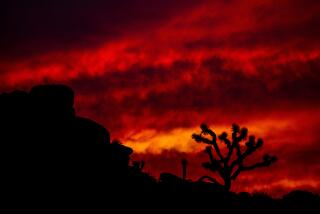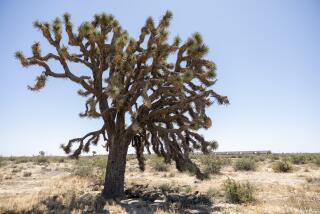A Destiny With Dates
- Share via
ABU AL KHASIB, Iraq — In the basin of the Shatt al Arab waterway, it’s 90 degrees at dawn and rising. They call these midsummer weeks in southern Iraq the palm oven days because it’s in the intense heat of July that the sweetness of autumn is made -- the dates cook, the sugars burn and the flavor cures.
Kamal Ayoob Khaleel, one man alone against an orchard of a couple of hundred trees, has this day begun the year’s date palm harvest, the first of the post-Saddam Hussein era.
Hussein’s rule was so complete even the dates felt his wrath.
In good times, the date harvest was eagerly awaited throughout the Middle East, and the arrival of the first dates, like the arrival of the first Beaujolais, was a time of high excitement.
But like so much else in Iraqi life, the business of dates was fundamentally altered for the worse during Hussein’s rule. The president, not always satisfied with merely executing or exiling his perceived enemies, also on occasion attacked their livelihoods. As part of his continuing feud with the Shiite Muslims who populate much of southern Iraq, where the main date harvest occurs, Hussein attacked the trees.
Iraqis like to say, with irony but no evident anger, that Hussein executed trees. In addition to simply chopping them down, he drained the swamps that gave them water. Drought further reduced the water supply and raised the salinity of what was left -- a double disaster.
Of the 9 million trees in Basra province, 6 million were destroyed. Overall, the country lost half its 30 million trees in 20 years. What had been the largest date industry in the world -- so esteemed that its varieties were planted as far away as California’s Coachella Valley -- declined in economic importance, making the trees less valuable and then, deepening the cycle of decline, less cared for.
The entirety of the country’s most valuable agricultural inheritance was at risk, said Dr. Abbas Jasim, director of the Date Palm Research Center at the University of Basra. Jasim did his postgraduate work at Kansas State University and saw there the effort by agronomists to preserve the genetic endowment of different crops by building tissue libraries. When he returned to Iraq in the early 1990s, he began creating such a library for palms. Because there are hundreds of varieties (including some so prized and expensive that most Iraqis have never tasted them), it was not an easy undertaking.
When Jasim eventually finished the library, he had samples of every palm native to Iraq growing in his lab. His timing was good. International sanctions had wrecked much of the country’s economy, and people were returning to the date orchards. They needed new stocks for replanting, and he provided them. The lab attracted new students, and the industry seemed set to rebound.
Then came the latest war.
The rampage that followed the fall of the Hussein government engulfed the university. The palm lab was no exception.
“Just destruction for the sake of destruction,” Jasim said.
Looters stole everything -- office furniture, air conditioners, even the autoclaves used in growing cell cultures. They dumped chemicals on the floor, smashed thousands of test tubes.
The theft of the air conditioners was the fatal blow. Once the temperature climbed above 90 degrees in the lab, everything that wasn’t stolen or broken died. Not a single tissue culture survived.
*
Khaleel, the date farmer, has more immediate concerns than the date palm genetic database. The capriciousness of farm life is evident on the ground at the base of his trees, where the remains of a field of okra sit gray and shrunken. There hasn’t been enough water to irrigate, and what little there is is so salty it actually killed some of the plants.
Khaleel, 40, was one of many people who came back to the date orchards as a sort of economic refugee, hoping to raise enough food to feed and clothe his family. He doesn’t own any land, instead leasing his plots for a percentage of the harvest.
Most of his fruit is not yet ready for market, but it’s worth finding that which is, because the early fruit gets five times the price of the later harvest. The fruit is given different names as it ages: khalal, rutab, tamr. It’s edible at all stages; it’s just not a date until the end.
The date has a place at the center of its native culture that has been achieved by few other foods -- rice in Japan, perhaps, or tortillas in Mexico. Its praises have been sung over the millenniums, beginning with the Assyrians 5,000 years ago. It is mentioned more often in the Koran -- 29 times -- than many of the prophets. The dates became and remain the preferred food to end the daily fasts of Ramadan. Arab women eat them during pregnancy for nutrition and during labor for relief.
Mary ate dates to relieve the pain of giving birth to Jesus. According to the Koran’s account, the tree was so beneficent that she didn’t even have to pick the fruit. “Shake towards thyself the trunk of the palm tree,” she was told. “It will let fall fresh, ripe dates upon thee.”
In real life, it’s not that easy.
Many of the trees are 100 feet tall, and shaking them appears to have little effect, which explains why Khaleel is at the moment higher than some birds. He’s parked 60 feet up in a metal rope and fabric sling, an air chair, in which he sits at a nearly perfect 45-degree angle from the trunk of the tree. He makes no evident effort to stay seated; gravity and the angle and weight of his body against the sling are all he needs to be secured. He might as well be sitting on a porch swing.
A tree can produce as much as a ton of fruit a year. The dates hang in as many as 20 large bunches, hundreds of dates per bunch. Although the trees fruit only once a season, the harvest lasts for months as the fruit ripens at varying speeds depending on where it is in the bunch. The center of the bunch, where it’s warmest and most humid, ripens first, so the dates must be picked from the inside out.
They’re not actually picked, but twisted off so as not to disturb the branch and the fruit left behind. Just touching the fruit leaves a trace of acid and a slight blemish. So the prey must be approached carefully, reaching into the middle of the bunch, touching nothing but the target dates.
The picker must come straight in; if he sweeps in from the side he risks the knife-sharp points of the palm fronds. Every approach is a chance for multiple stab wounds. A cat burglar couldn’t be more careful.
The soft, angled light of early morning hasn’t lasted long, turning hard in a hurry. It punishes, and by 9 a.m. it will be too hot to do much more than breathe. Khaleel will break, tend to other chores, then return in the evening.
He is barefoot and unhurried. He slides up and down the tree by easing his weight away from the sling and walking on the rough bark. He has a cloth satchel looped around his neck, resting on his stomach. He picks and deposits into the sack, then dumps the results on the ground. A boy from the market will come by and collect it at day’s end.
The war did some damage to the palms, but compared with the rest of the country it was slight. Just down the road, Mohammed Jasin Khaleel, owner of a large date orchard, points to where his trees got trimmed by machine-gun fire in a fight on the nearby road. Some unexploded ordnance was left in the deep grass.
There are other problems. Even when water is available, Khaleel, who is not related to the date farmer, needs electricity to drive the pumps to irrigate his trees. Power isn’t always available off the grid. He has a generator to fill in the gaps, but fuel for it is sometimes hard to come by.
Mohammed Khaleel no longer climbs the trees himself. He has retired to management, and from the look of him, this occurred more than a few years ago.
He has a crew of students and ex-students who’ve been picking for him for most of a decade. Pick today, take tests at the university -- or what’s left of it -- tomorrow, they said. Workers must pick two boxes of fruit a day to earn their wages. There is a casualness to the whole enterprise. No rush or pressure.
Mazin Abbou, one of the students, is only 15 years old and already is in his fourth year in the palms. “As soon as you get used to it, it’s easy,” he said. Shoeless, capless, lithe and tousled, he hasn’t learned yet that this is work and wants to climb the tallest trees, which he does in a scamper.
Up in another tree sits an old man, grayed and scrawny and slightly unkempt. He’s a pensioner who has come out to harvest because he likes it. He waves and smiles from his perch.
Go virtually anywhere in Iraq today, and people can be seen milling about. These aren’t vagrants, but often anxious middle-class wage earners. They’re waiting, wondering what to do and when they can do it. There’s a group of people like that at Abbas Jasim’s lab in Basra -- fellow professors, lab technicians and students, several of whom lost all the work for their dissertations when the place was ransacked.
The lab is full of broken glass and ancient office furniture that has been scrounged to replace what was stolen. The loss of the facility will hurt the Iraqi date industry more in the long term than the short, in the loss of its science more than its trees. With or without the lab, trees planted now will take on average a decade to reach maturity.
Jasim said he would try to find the money to rebuild not just the lab but also the large part of his life that went with it. It will take time. He met recently with Americans who control the money for Iraq’s reconstruction. He said he couldn’t tell where dates fell on their priority list, but he hadn’t heard back. He’s waiting.
Outside, even the trees lining the drive to the research center have been taken. These went later, long after the looting.
People have gone scavenging for wood because liquefied petroleum gas, with which they cook, is in short supply after saboteurs damaged the refineries.
Every single tree on the road has been reduced to a stump, yet another of the war’s still widening ripples.
More to Read
Sign up for Essential California
The most important California stories and recommendations in your inbox every morning.
You may occasionally receive promotional content from the Los Angeles Times.










